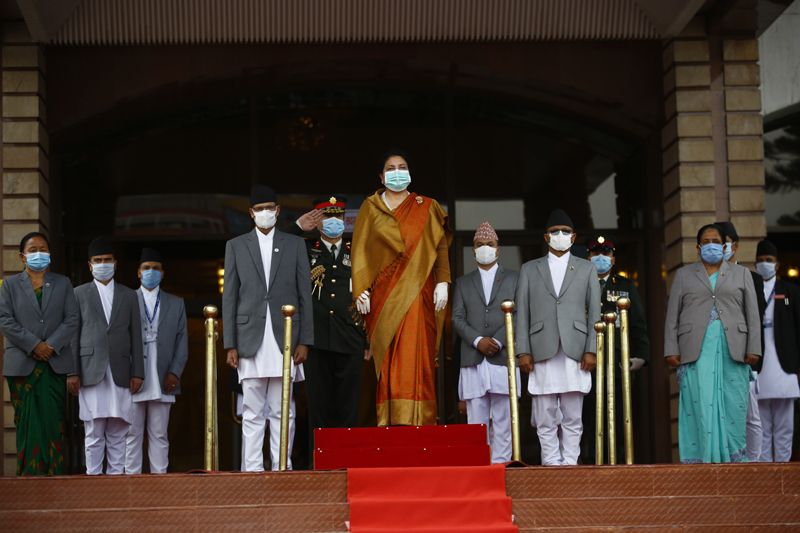Plan to revive COVID-hit economy missing
Financial liabilities that govt’s programmes will create aren’t easily bearable, say experts
Kathmandu, May 15
President Bidhya Devi Bhandari today presented the government’s policies and programmes for fiscal 2020-21 at the joint session of the Parliament that lacked any concrete plan to revive the economy from the turbulence created by the outbreak of the COVID-19 pandemic.
Though President Bhandari said the government’s priorities for the next fiscal would change due to coronavirus and would basically dwell on health, education, job creation and revival of the economy, there were no concrete plans to revive the economy from the pandemic’s shock while ongoing megaprojects and other ambitious railway and waterway projects have been prioritised.
However, the policies and programmes have mentioned expanding health services and infrastructure and promoting business, investment and commercial agriculture to generate additional job opportunities.
Even officials at the Ministry of Finance, who spoke on the condition of anonymity, admitted that it would be a tough challenge to implement numerous programmes that the government had decided to undertake next year amid limited resources and new liabilities caused by the coronavirus.
Economist Biswo Poudel opined that implementation of all the projects and programmes announced by the government will require a budget of over Rs 2 trillion.
“The government presented its programmes as if it has surplus financial resources. While attempting to make everyone happy, the government has missed out on concrete relief and other measures to help the country revive from the shock of COVID-19,” he added.
It appears the government is not so serious in dealing with the challenges created by the pandemic for the economy, said Poudel.
Though the government stated that inland revenue would be promoted as a major source of revenue, experts said inland revenue could not bear the burden of financial liabilities that the government had created for the next fiscal.
On the health and education fronts, the government has announced it will open hospitals across all local levels and trauma centres along major highways. The government has also given priority to standardising local, regional and national hospitals. The government has also announced to insure all Nepalis within the next three years.
“To free Nepal from the COVID-19 contagion will be the top priority of the government,” said President Bhandari. She also announced that health desks and quarantine centres would be set up across all major border checkpoints.
The government will focus on standardising education system and declare Nepal fully literate by the end of the next fiscal.
The government has also decided to mobilise graduate youths in educational development works.
The government will emphasise on labour management in the new context and circumstances in the next fiscal. It will incorporate both formal and informal sector workers in the contribution-based social security programme of the government and mobilise returnee migrant workers in agriculture, industry, construction and services sectors.
It will develop Prime Minister Employment Programme as the major source of employment for people and ensure better relations in the labour market. The government will provide initial capital for returnee migrant youths and promote entrepreneurial growth.
The government will effectively implement its earlier decision to give loans to youths against collateral of their academic certificate and help them in project development.
It will adopt austerity measures in public expenses and reprioritise projects based on their priority, besides seeking and promoting foreign investment in mega projects.
The government will provide incentives to export-oriented industries and encourage production-based firms in the country. It will revive sick public enterprises, boost exports and trade with other countries and set up bilateral economic zones to promote trade.
The government will provide necessary incentives to industries severely affected by the pandemic.
It also plans to start using seven Chinese ports for international trade from the upcoming fiscal year.
On the infrastructure front, priority has been given to ongoing airport projects. While Gautam Buddha International Airport will start functioning from the next fiscal, the government also plans to complete Pokhara International Airport by the next year.
It will complete Kathmandu-Tarai Fast Track Project within the next three years, Upper Tamakoshi Hydropower Project within the next year and start the construction of Budhigandaki Hydropower Project.
It will start work to open track of Koshi and Karnali corridors, expedite construction of Nagdhunga Tunnel and start tunnel works along Siddhartha Highway (Sidhababa section).
Focusing on energy production, the government has also set a target to raise per capita electricity consumption to
350 kilowatt per hour by the next fiscal.
The government will give high priority to railway and waterway projects.
It will develop waterways facility in the Koshi, Karnali and Gandaki rivers by linking them to Indian waterways. It will start initial works of Birgunj-Kathmandu and Rasuwagadi-Kathmandu railway projects within the next fiscal year.
The government will run a campaign next year in a bid to promote production and use of domestic products. It also plans to complete all post-earthquake reconstruction works within the next fiscal year.
A version of this article appears in e-paper on May 16, 2020, of The Himalayan Times.






